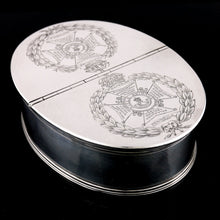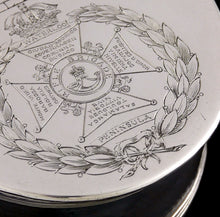Rifle Brigade - Regimental Presentation Table snuff Box, 1856
- Regular price
- £2,800
- Sale price
- £2,800
- Regular price
-
- Unit price
- /per
Adding product to your cart
13cm (5.2in) x 9.5cm (3.7in) x 4cm (1.5in)
Silver. Table Snuff Box of ovoid form with double compartmented interior and corresponding twin hinged lids, each engraved to the exterior with wreathed Maltese cross, battle honours and Guelphic crown of the Prince Consort's Own; the gilt interior engraved ‘Presented By Captns. Ross and Egerton / on the formation of the Battalion / Mess of the 3rd Batt Rifle Brigade / April 1856’. Maker's mark of Charles Rawlings & William Summers. Weight: 362.4g. Hallmarked London 1855.
Read more

General Sir John Ross GCB, DL (1829-1905) was the son of the Peninsula and Waterloo veteran Field Marshal Sir Hew Dalrymple Ross (1779-1868), and was commissioned as a Second Lieutenant into the Rifle Brigade in 1846. Between 1854 and 1855 he saw active service in the Crimea, at the battles of the Alma and Inkerman and the siege of Sebastopol. In 1856 he was promoted Major and went out to India. After active service at Cawnpore and Lucknow during the Mutiny (1857-58), he was appointed to the command of an elite camel corps drawn from the 2nd and 3rd Battalions for the purpose of hunting down rebel groups in Rohilkund and Oudh. Each riflemen had a camel with a native driver to guide the animal. Exceptional speeds of up to 7 miles per hour were possible. Once in the vicinity of the enemy, the men would dismount in order to fight. In May 1858, Sir Colin Campbell, Commander-in-Chief of the Army in India (later 1st Baron Clyde), declared the Camel Corps to be a corps d’élite. Long marches were frequently undertaken in extremely hot weather as the newly-promoted Lieutenant-Colonel Ross recalled: ‘We had lots of hard, tedious work, and never once all the time I was in command had I to speak a second time to either officers or men. Each seemed to take pleasure in doing what he had to do and in assisting me in every way.’ The Camel Corps was disbanded in June 1860 and Ross was appointed a Companion of the Order of the Bath. In 1863–64 he saw active service on the North West Frontier. Promoted Brigadier-General in the Bengal Army in 1874, Ross commanded the Perak Expedition of 1875-76. In 1881 he was knighted, and between 1881 and 1886 he commanded the Poona Division of the Bombay Army, before going to North America as GOC Canada. In 1891 Ross was promoted full General and he retired the service in 1896. He was appointed Colonel of the Leicestershire Regiment in 1895, and became Colonel-Commandant 3rd Battalion, Rifle Brigade in 1903.
Colonel Sir Philip le Belward Grey Egerton, 11th Baronet (1833–1891) was the son of Sir Philip de Malpas Grey-Egerton. He was commissioned into the Rifle Brigade in 1852 and served with the 2nd Battalion in the Crimea, being present at the battle of the Alma and the siege of Sebastopol. On his return to the family seat, Oulton Park in Cheshire, he received a hero’s welcome from family, tenants and retainers, and a guard of honour provided the local yeomanry. Moreover his faithful dog ‘Jet’ greeted him with a specially penned address attached to his collar which was read aloud to the assembled company causing much mirth. He transferred to the Coldstream Guards in 1857. On 18 July 1861, Egereton married Henrietta Elizabeth Sophia, daughter of the 1st Baron Londesborough. He succeeded his father as Baronet in 1881, and was Deputy Lieutenant of Cheshire, and Hon. Lieutenant-Colonel, 4th Battalion, Cheshire Regiment.










